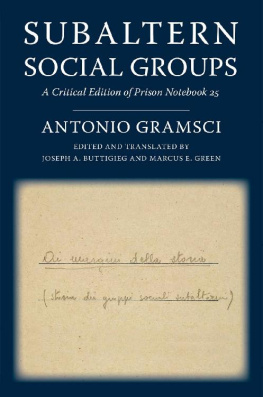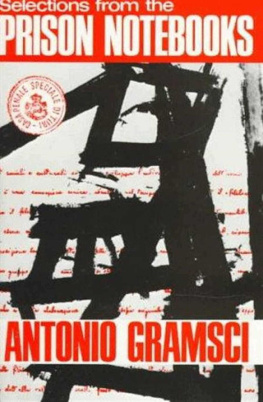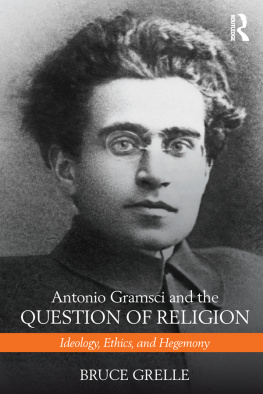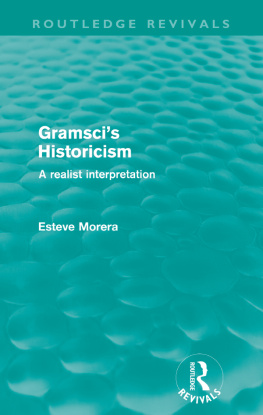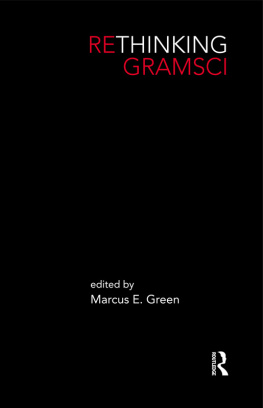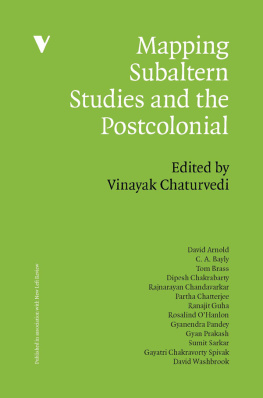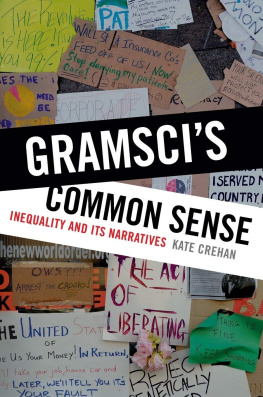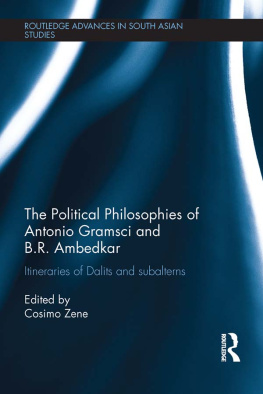Antonio Gramsci - Subaltern Social Groups: A Critical Edition of Prison Notebook 25
Here you can read online Antonio Gramsci - Subaltern Social Groups: A Critical Edition of Prison Notebook 25 full text of the book (entire story) in english for free. Download pdf and epub, get meaning, cover and reviews about this ebook. City: New York, year: 2021, publisher: Columbia University Press, genre: Romance novel. Description of the work, (preface) as well as reviews are available. Best literature library LitArk.com created for fans of good reading and offers a wide selection of genres:
Romance novel
Science fiction
Adventure
Detective
Science
History
Home and family
Prose
Art
Politics
Computer
Non-fiction
Religion
Business
Children
Humor
Choose a favorite category and find really read worthwhile books. Enjoy immersion in the world of imagination, feel the emotions of the characters or learn something new for yourself, make an fascinating discovery.
- Book:Subaltern Social Groups: A Critical Edition of Prison Notebook 25
- Author:
- Publisher:Columbia University Press
- Genre:
- Year:2021
- City:New York
- Rating:3 / 5
- Favourites:Add to favourites
- Your mark:
- 60
- 1
- 2
- 3
- 4
- 5
Subaltern Social Groups: A Critical Edition of Prison Notebook 25: summary, description and annotation
We offer to read an annotation, description, summary or preface (depends on what the author of the book "Subaltern Social Groups: A Critical Edition of Prison Notebook 25" wrote himself). If you haven't found the necessary information about the book — write in the comments, we will try to find it.
Subaltern Social Groups: A Critical Edition of Prison Notebook 25 — read online for free the complete book (whole text) full work
Below is the text of the book, divided by pages. System saving the place of the last page read, allows you to conveniently read the book "Subaltern Social Groups: A Critical Edition of Prison Notebook 25" online for free, without having to search again every time where you left off. Put a bookmark, and you can go to the page where you finished reading at any time.
Font size:
Interval:
Bookmark:
SUBALTERN
SOCIAL GROUPS
European Perspectives
European Perspectives
A Series in Social Thought and Cultural Criticism
Lawrence D. Kritzman, Editor
European Perspectives presents outstanding books by leading European thinkers. With both classic and contemporary works, the series aims to shape the major intellectual controversies of our day and to facilitate the tasks of historical understanding.
For a complete list of books in the series, see .
SUBALTERN
SOCIAL GROUPS
A Critical Edition of Prison Notebook 25
Antonio Gramsci
Edited and translated by
Joseph A. Buttigieg and Marcus E. Green
COLUMBIA UNIVERSITY PRESSNEW YORK
Columbia University Press
Publishers Since 1893
New YorkChichester, West Sussex
cup.columbia.edu
Copyright 2021 Columbia University Press
All rights reserved
E-ISBN 978-0-231-54886-1
ISBN 978-0-231-19038-1 (hardback)
ISBN 978-0-231-19039-8 (trade paperback)
LCCN 2021936606
A Columbia University Press E-book.
CUP would be pleased to hear about your reading experience with this e-book at .
Cover image: Fondazione Gramsci, Archivio Antonio Gramsci, title page of Notebook 25
Cover design: Milenda Nan Ok Lee
For Anne, Peter, Dolores, and Sebastian
CONTENTS
- MARCUS E. GREEN
In the summer of 1934, Antonio Gramsci, then a patient at the Cusumano health clinic in the city of Formia, began to collect and organize his miscellaneous notes on subaltern classes and subaltern social groups into a new notebook, which he titled On the Margins of History (The History of Subaltern Social Groups) (Ai margini della storia [Storia dei gruppi sociali subalterni]). Though still a prisoner and under police guard, Gramsci obtained access to all of his notebooks for the first time in Formia. To create order among the thousands of notes he had previously written in Turi prison, he began to collate, copy, and sometimes modify and expand his first draft notes into single notebooks devoted to monographic themes, what he described as special notebooks. While in Formia, he started working on twelve special notebooks, including Notebook 25.
Gramsci began working on Notebook 25 in July or August 1934. Though he had not previously identified the examination of subaltern classes or groups as a major area of focus in his carceral studies, he had written dozens of notes on the topic between June 1930 and May 1933, including seventeen notes under the general rubric history of subaltern classes (storia delle classi subalterne), which remained scattered across hundreds of pages in his prison notebooks. In the composition of the special notebooks, Gramsci discovered that his notes on subaltern classes constituted a thread of analysis that he needed to capture in monographic form. He likely expected the special notebook to amount to a large study, as he chose a 160-page notebook for the topic. Following his practice in Notebooks 1922, he reserved the first ten pages of the notebook for introductory remarks. As in Notebook 20, the first ten pages of Notebook 25 are blank; Gramsci never completed the introduction he intended to write. Only pages 1127 contain text, leaving the notebook largely unused, with dozens of notes on the topic remaining unincorporated in his early notebooks.
This volume comprises all of Gramscis writings on subaltern social groups composed during his years of imprisonment by Mussolinis fascist regime. Adapted from Valentino Gerratanas critical Italian edition of the Quaderni del carcere (1975), the volume provides a complete English translation of Notebook 25 On the Margins of History (The History of Subaltern Social Groups), as well as Gramscis first draft notes (what Gerratana designated as A texts) on subaltern classes and subaltern groups, single draft notes that Gramsci did not copy or cross out (B texts), and second draft notes (C texts) that relate to subaltern social groups but appear in other special notebooks. This volume also includes Gramscis notes that pertain to his treatment of the simple and the humble, which interconnect with his examination of subaltern classes and groups. Among Gramscis substantive reflections on subaltern classes and groups, he interspersed transcriptions and paraphrases from newspaper and journal articles, bibliographical references, notations from publishing house catalogs, names, and epigrammatic quotations, often conveying minimal information and with little, if any, explanation. These materials are included in this volume, for they illustrate how Gramsci workedhow he recorded, organized, and revised his ideasallowing one to trace the genealogy of one of his most influential concepts.
Notebook 25 is almost entirely composed of notes Gramsci originally wrote in Turi prison, with some minor elaborations and additions. It is comprised of eight second draft notes (C texts). Gramsci composed those eight notes from a compilation of fourteen first draft notes (A texts) that originally appeared in Notebooks 1, 3, and 9. Only four of the A texts are written under the rubric history of subaltern classes. The ten other A texts do not contain the phrase history of subaltern classes nor do they immediately appear to connect to the theme of subalternity in their first draft. For instance, Gramsci included a group of notes in Notebook 25 with the rubric Utopias and philosophical novels, which in their draft form do not explicitly relate to the analysis of subaltern social groups. With Gramscis placement of the notes in Notebook 25, their connection to the study of subaltern groups is brought into relief.
In addition to the notes included in Notebook 25, several other notes directly relate to Gramscis treatment of subaltern social groups and classes. Of the seventeen notes with the heading history of subaltern classes that appear in the miscellaneous notebooks, Gramsci utilized only seven of them in special notebooks, thus retaining ten single-draft B texts, which he never revised. Though these notes largely consist of bibliographic references and short memoranda, they provide a record of how Gramsci approached the study of subaltern social groups and provide a glimpse of how he worked. Beyond the notes with the history of subaltern classes rubric, other miscellaneous notes, falling under a range of headings, address closely related issues, such as spontaneity, common sense, education, economism, and custom and laws, among others. Gramsci also incorporated the analysis of subalterns in other special notebooks, apart from Notebook 25, addressing a range of issues, such as the philosophy of praxis (Notebook 10), the concept of an intellectual and the Catholic Churchs representation of the simple (Notebook 11), the analysis of politics (Notebook 13), the formation of autonomous historical consciousness (Notebook 16), representations of the humble in literary works (Notebook 21), folklore (Notebook 27), and language and grammar (Notebook 29). Following Gramscis composition of his carceral writings over time, it becomes apparent that his examination of subaltern classes and groups constitutes a leitmotif that traverses the Prison Notebooks, intersecting and enriching seemingly disparate lines of inquiry, from intellectuals and philosophy to common sense, religion, and political transformation.
The idea for this volume emerged in the summer of 2006. At the time, Joseph A. Buttigieg was preparing volume 3 of the Prison Notebooks for publication, and I was in the process of writing the last chapter of my PhD dissertation. Joe sent me draft translations of notes from volume 3 that pertained to my work on subaltern groups, and I shared with him a translation of Notebook 25 that I had completed and started to annotate. Given the growing interest in subaltern studies, Joe thought it would be valuable to publish Notebook 25 along with Gramscis miscellaneous notes connected to the topic of subaltern groups in a single volume, separate from his complete critical edition of the
Next pageFont size:
Interval:
Bookmark:
Similar books «Subaltern Social Groups: A Critical Edition of Prison Notebook 25»
Look at similar books to Subaltern Social Groups: A Critical Edition of Prison Notebook 25. We have selected literature similar in name and meaning in the hope of providing readers with more options to find new, interesting, not yet read works.
Discussion, reviews of the book Subaltern Social Groups: A Critical Edition of Prison Notebook 25 and just readers' own opinions. Leave your comments, write what you think about the work, its meaning or the main characters. Specify what exactly you liked and what you didn't like, and why you think so.

